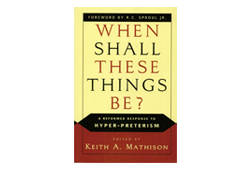One Column Page
and responsive to boot
Keith Mathison and the Biblical Time Statements, pt. 5
by
Don K. Preston, D. Div.
This article appeared in the 2021 Fall issue of Fulfilled! Magazine
Having looked at Mathison’s
claim of “telescoping” prophecies in our previous article,
we now turn our attention to his claim of double, or
multiple, fulfillments:
"If Old Testament prophecy provides us with any kind of standard for understanding New Testament prophecy, then the possibility of double fulfillment or prophetic telescoping cannot be automatically ruled out either.” (When Shall These Things Be? 180)

Mathison falls back on the nature
of Old Testament prophetic fulfillment to supposedly find
support for allowing “near” to not mean near. Of course, one
of the first problems with Mathison’s argument is that it
admits, right off the bat, that there was an imminent
fulfillment of the prophecy. He is saying that the
prophecies—those he claims had double fulfillment—had a
fulfillment in the days of the audience to whom the
prophecies were given, but they also looked far beyond that
fulfillment to some future time unknown to them. This is
supposed to prove that time statements are elastic and
plastic—“silly putty” that can be stretched and manipulated
into essentially meaning nothing. But this is a
self-defeating argument.
If, as just indicated, there
truly was a fulfillment of these Old Testament prophecies
that was imminent to the original audience, then that means
that the language of imminence was objective, valid, and
true. But to then say that the language that was indeed
fulfilled imminently, was fulfilled again centuries, or
perhaps millennia, later, turns language on its head. This
has Mathison arguing that “at hand” truly meant at hand, but
it also meant not at hand!
But the “multiple fulfillments”
argument is full of implications that Mathison himself would
never accept. Which prophecies had double or multiple
fulfillments, and how does the Bible student discern them?
Is there a solid hermeneutical rule that can be applied to
Old Testament texts that tells us that prophecy X was to
have double or multiple fulfillments, but prophecy Y wasn’t?
Just how far does Mathison carry
his claim of “double or multiple fulfillment”? (Mind you,
Mathison is not talking about type and anti-type, but actual
“multiple fulfillments.”)
Would Mathison affirm that there
were to be—perhaps are still to be—multiple fulfillments of
the prophecy of the virgin birth (Isaiah 7:14)? If not, why
not? What are his criteria for denying that possibility?
What about the Great Tribulation?
Mathison is on record saying that the Great Tribulation
occurred in the first century and was connected with the
Jewish judgment:
“There is no end time
tribulation. Jesus’ prophecy about tribulation in Matthew 24
was fulfilled between AD 30 and AD 70.” (Keith Mathison,
Dispensationalism: Rightly Dividing the House of God?
(Phillipsburg, NJ; P & R Publishing, 1995, 144).
But wait! If prophecy has
multiple fulfillments, how can Mathison reject the
dispensational claim that while the Jewish War was horrific,
perhaps even in some way fulfilling the prophecy of the
Tribulation, the “real” fulfillment lies in our future? I
mean, if the hermeneutic of multiple fulfillments of
prophecy is valid, we need to know how Mathison determines
which prophecies were to be fulfilled multiple times, and
which prophecies were not.
And what about the death of
Christ on the Cross? Will there be multiple fulfillments of
that substitutionary (horrific) death by our Lord and more
resurrections of the Lord?
And what of the establishment of
the kingdom? Will the kingdom be established over and over
and over again?
What about the last days’ sending
of the Holy Spirit (Acts 2)? Joel does not speak of two or
more such events, and Peter was emphatic that Joel’s
prophecy was being fulfilled on that auspicious Pentecost
2000 years ago. But perhaps there are multiple fulfillments?
How can we determine that?
And just how many times are we to
expect the coming of the Lord, in multiple fulfillments of
His prophecies to come? Of course, this is where Mathison’s
hermeneutic quickly gets really sticky. Like many
postmillennialists, Mathison has traditionally agreed that
Christ came in AD 70, on the clouds, with the angels, the
sound of the trumpet, etc., to gather the elect. So, we have
a coming of the Lord in AD 70—but then, in the
postmillennial paradigm, we have yet another coming of the
Lord at the end of the current Christian age. (It is to be
noted that Mathison now claims that all “coming of the Son
of Man” passages referred to Christ’s ascension, and not to
His Second Coming—Mathison, Age to Age, 2009, 269,
365. It takes little effort to debunk that theory.)
Now, it is common for
postmillennialists and some amillennialists to claim that AD
70 was a type or foreshadowing of the “real” coming of the
Lord. Kim Riddlebarger says:
In the context of predictive
prophecy and prophetic perspective, the intent would be that
the destruction of the temple and the tribulation brought by
the Roman army is a type of greater wrath experienced
immediately before the return of Christ, perhaps connected
with the loosing of Satan (Revelation 20:7f) and this on a
global, not a local scale. This means that Jerusalem and the
temple are, perhaps, a type of the apostate church in the
last days.” (Kim Riddlebarger, Amillennialism, Grand
Rapids, Baker, 2003, 262, n. 34)
Kenneth Gentry, Jr., likewise
posits AD 70 as typological:
Theologically, a
redemptive-historical link does in fact connect AD 70 with
the second advent. This could easily confuse the disciples.
That is, the AD 70 episode is an anticipatory foreshadowing
of the larger event, the second advent. (Kenneth Gentry,
Revelation Made Easy, Powder Springs, Ga.; American
Vision, 2009, 47)
I have not been able to find
whether Mathison posits AD 70 as a type and shadow of the
real end / Parousia, but given his “multiple fulfillment”
construct, it would certainly appear that he would accept
that claim.
The problem(s) with Mathison’s
“multiple fulfillment” claim should be more than apparent.
It is arbitrary. Furthermore, what is revealing is that
neither Mathison, Gentry, nor anyone else that I have read
actually attempts to prove that AD 70 was a type or shadow
of a yet future coming of the Lord, and they do not offer
textual proof that there are multiple comings of the Lord.
All they do is assert, but assertion is not proof.
For a thorough critique and
refutation of the “multiple fulfillment” hermeneutic, get a
copy of my book AD 70: A Type of the “Real” End? It
is available from my websites, Amazon, Kindle, and other
retailers.
Summary and Conclusion
We have examined Mathison’s
arguments as he has attempted to convince his readers that
time statements indicating the imminency of the end of the
age, the coming of the Lord, and the judgment are not to be
taken seriously as objective time indicators.
- We have addressed Mathison’s
claims that certain Old Testament prophecies with
imminent time statements (Isa 13:22 and Hab 2-3) were
not fulfilled until perhaps 200 years later. (2020 Fall
issue)
- We have shared with the
reader how Mathison’s own writings exhibit a confused
and self-contradictory view of time statements. On the
one hand he has always affirmed the objective nature of
the imminence of the kingdom and of the events of AD 70.
But now, in his efforts to counter the truth of Covenant
Eschatology, he seemingly rejects his own writings on
this topic. This seems like “argumentum ad desperatum”
(my non-Latin “Latin” term that I coined years ago to
describe “arguments from desperation”)! (2020 Winter
issue)
- We have exposed how
Mathison’s appeal to Haggai is misguided and violates
history and Scripture. (2021 Spring issue)
- We have shown how his appeal
to Daniel is actually a misrepresentation of the
emphatic words of Daniel 10:4, 14, and have falsified
his claims that the ancient prophets spoke as if events
were near when in fact they were far off (telescoping).
His claim of “telescoping” prophecies is untenable at
all levels. (2021 Summer issue)
- We have refuted Mathison’s
claim that prophecies are to be fulfilled multiple
times. (This issue)
I believe we have effectively shown that Mathison’s Objection is overruled!
Comments:
Your honest review will help others in their search for truth. If you must leave a negative review please be gracious.
Rather, speaking the truth in love, we are to grow up in every way into him who the head, into Christ . . . .
(Ephesians 4:15)
We use "Disqus" commenting software. If you are not familiar with "Disqus," click here for more information. You don't need a Disqus account to post comments, however, without an account you won't be notified if someone responds to your post.
 Fulfilled
Fulfilled